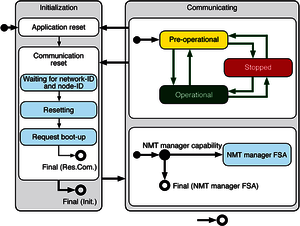Network management (NMT)
All CANopen FD devices support the network management (NMT) server state automaton. The NMT server state automaton defines the communication behavior of a CANopen FD device. The NMT server state automaton consists of an Initialization state, a Pre-operational state, an Operational state, and a Stopped state. After power-on or reset, the CANopen FD device enters the Initialization state.
After the device initialization is finished, the device automatically transits to Pre-operational state and indicates this transition by requesting the Boot-up service. This way the device indicates that it is ready to work. The Pre-operational state is intended for starting of all CANopen FD devices essential for system runtime and may include detection, configuration, and verification of the configuration by the active NMT manager. For these tasks, mainly the USDO service is used. In addition, a device that stays in Pre-operational state can use the SYNC, Time Stamp, or Heartbeat service, if these services are supported and enabled. The PDO service is disabled in this state. PDO communication is only possible in the Operational state. During Operational state, the device can use all supported communication objects. The Stopped state is the counter part to the Operational state. No communication services are supported, except of the NMT service as well as the error control services.
Initilization state
The Initialization state covers the substates Reset Application, and Reset Communication. When the CANopen FD device enters this NMT server state automaton, the CANopen FD device inherits the bit rate from the CAN device. The two substates Reset Application and Communication were introduced to enable partial reset commands. During Reset Application all parameters in the object dictionary range from 2000h to 9FFFh are set to the power-on or default values. After setting the power-on values, the NMT substate Reset Communication is entered autonomously. During the Reset Communication substate, the parameters of the communication profile (Index range 1xxxh) are set to their power-on/default values. In addition the node-ID and the network-ID are set. After this state, the Initialization state is left.
NMT protocol
The NMT protocol is transmitted by the active NMT manager in a CANopen FD network. The reception of the NMT protocol forces the CANopen FD devices to transit to the commanded NMT state. The NMT protocol is mapped to a single CAN FD data frame with a data length of two bytes. The first byte contains the command specifier and the second contains the address of the CANopen FD device(s) that have to perform the command (if this value is equal to 0, all CANopen FD devices have to perform the commanded state transition). The NMT protocol uses the CAN-Identifier 0, the highest prior CAN-ID in a CAN-based system.
